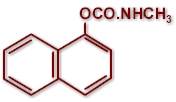Carbamates are organic compounds characterized by being esters of carbamic acid (NH2-COOH). They represent a chemical class of pesticides discovered in the 1950's with broad insecticidal and acaricidal activity.
Their use in ruminants or horses has always been scarce, but they are still used in swine and poultry (typically as dusts) and in dogs and cats as shampoos, soaps, powders and the like. They are also quite frequent in agriculture and hygiene, both public and domestic.
All carbamates are veteran antiparasitics, i.e. they have lost patent protection long ago and are available as generics manufactured by numerous chemical companies (typically in China, India, Israel, Brasil, etc.).
Click here for a general introduction to ectoparasiticides and their most important features.
Mode of action and characteristics of carbamates

Carbamates act on the nervous system of the parasites (but also of mammals, birds, fish and many organisms!) as inhibitors of acetylcholinesterase (also known as AchE), an enzyme that hydrolyzes acetylcholine (Ach). Ach is a molecule involved in the transmission of nervous signals from nerves to muscles (so-called neuromuscular junctions) and between neurons in the brain (so-called cholinergic brain synapses).
AchE's role is to terminate the transmission of nervous signals where Ach is the neurotransmitter (there are several other neurotrasmitters). By inhibiting the activity of AchE, carbamates prevent the termination of those nervous signals, i.e. the neurons remain in constant activity and excitation, massively disturbing the normal movements of the parasites. The bottom line for the parasites is that they are paralyzed and die more or less quickly.
Carbamates bind reversibly to AchE, in contrast with organophosphates, another chemical class of parasiticides, which bind irreversibly to AchE.
Active ingredients

- Carbaryl: Broad spectrum insecticide and acaricide. Used in dusts for pig and poultry, wound dressings against fly maggots and shampoos, soaps, sprays and the like for dogs and cats.
- Methomyl: Broad spectrum insecticide. Used in certain housefly baits. Not used not on-animals.
- Propoxur: Broad spectrum insecticide and acaricide. Used in some collars, soaps, powders and the like for dogs and cats and for premise and environmental treatments.
Although extensively used in agriculture, veterinary use of carbamates was and rermain scarce, probably because they are usually less effective against veterinary parasites than organophosphates or pyrethroids.
Safety of carbamates
The toxicological properties of carbamates are similar to those of organophosphates, since both are inhibitors of acetycholinesterase.
Correctly used, most products containing carbamates are well tolerated by livestock, horses and pets. But the potential risks in case of accident or incorrect use shall not be underestimated.
Strict compliance with safety and use instructions in the product label is a must when dealing with carbamate compounds, especially with concentrates for dipping and spraying. Otherwise the risk of serious poisoning of both operators and animals is real.
It is also essential to correctly store such products, especially avoiding high temperatures, never used them after the expiry date, and to consume all the product in open containers within the deadline indicated in the label (if there is no indication, ensure that this is done within a few weeks, better within a few days).
Carbamates are problematic for the environment. They do not accumulate in the food chain because they are usually either metabolized through microorganisms in the soil or otherwise break down to less toxic molecules in the soil. Usually they are also metabolized by treated animals and excreted metabolites are not toxic. However, carbamates are toxic to birds and other wildlife.
It is therefore very important to follow the label instruction for the disposal of dipping solutions or any other product remainders. In some countries such instructions are so strict and consequently so expensive, that treatment costs of such products becomes prohibitive.
Additional specific information (toxicity, intoxication symptoms, adverse drug reactions, antidote, etc.) on the safety of carbamate active ingredients for veterinary use is available in specific articles in this site:
General information on the safety of veterinary antiparasitics is available in specific articles in this site (click to visit):
- General safety of antiparasitics for domestic animals
- General safety of antiparasitics for humans
- General safety of antiparasitics for the environment
|
WARNING Never use livestock, horse or poultry products on dogs and/or cats, unless explicitly approved for dogs and/or cats too. Without reliable use instructions they can be easily overdosed, and pets may not tolerate formulations developed for use on livestock, horses and/or poultry. Some active ingredients may be toxic to particular animals. Never use agricultural or hygiene products on livestock, horses, poultry or pets, unless explicitly approved for veterinary use, which is quite unusual. Even if the specific active ingredient is approved for some veterinary use. The formulations for agricultural and/or hygiene use are mostly different than those for veterinary use and may be toxic to or not be tolerated by animals. It is obvious that veterinary medicines are not intended for and should never be used on humans!!! |
Parasite resistance to carbamates
Having the same mode of action, carbamates have cross-resistance with organophosphates, i.e. if a parasite population has developed resistance to organophosphorous compounds, it is very likely that they have also acquired a certain degree of resistance to carbamates, and vice versa.
The species with reported resistance to carbamates and for which it is likely to find resistance problems in livestock, horses or pets are houseflies (Musca domestica), various mosquito species, dog and cat fleas (Ctenocephalides spp.) and red poultry mites (Dermanyssus gallinae).
Visit also the articles in this site about parasite resistance to antiparasitics and how it develops.